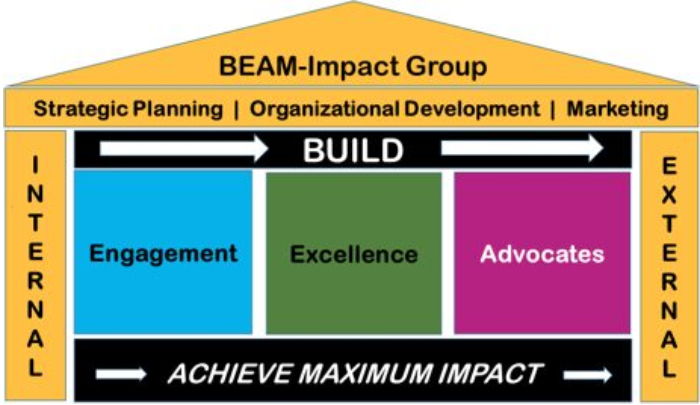Set the Priorities Right to Achieve Maximum Impact
B.E.A.M.-Impact Generator© adheres to the following guiding principles, practices, and assumptions in helping our clients achieve their vision and mission:
The Essential Road Map
1. The over-arching and fundamental requisite for any organization to achieve its vision, mission, and maximum societal impact effectively is a well-constructed STRATEGIC PLAN.
A strong Strategic Plan is the essential roadmap for focusing an organization on the right priorities that will achieve maximum impact and create value for diverse stakeholders, including constituents served, staff, beneficiaries, donors, investors, suppliers, and society at large.
The Strategic Plan must reflect specific, measurable, attainable, relevant, and time-based (SMART) goals that are championed by EVERYONE – from the organization’s trustees to the organization’s director and among all staff and volunteers.
In these challenging times for all nonprofits, the Strategic Plan is a key requisite for effective nonprofits to raise crucial funds – for the short-run as well as long-term – and especially in managing through crises. The Strategic Plan ensures that the organization’s staff and board are using their time and talent effectively to achieve the mission and vision, which will also help build and sustain deeper engagement with the organization’s donors.
Excellence in Achieving the Vision & Mission
2. To ensure successful mobilization of the Strategic Plan, focused on the right outputs, outcomes, and desired impacts, ORGANIZATIONAL DEVELOPMENT is essential.
The primary responsibility and accountability for the development and oversight of the Strategic Plan reside with the organization’s board of directors and chief executive. However, the ultimate effectiveness of the Strategic Plan is evaluated on its impact and value creation. Without staff engagement and enthusiasm, excellence is unattainable, and the nonprofit organization’s Strategic Plan is a static, ineffective document.
Achieving maximum beneficial impact hinges on leadership’s commitment to involve staff at every level in the nonprofit’s Strategic Planning process and obtain their explicit commitment to the operational priorities stated by the plan. It is crucial to keep the spotlight on the plan, reinforcing it often with the board, staff, and volunteers. Developing and updating communications vehicles that respect diversity, inclusion, equity, and accessibility (DEIA) for all is key.
Ongoing organizational development with board, staff, and volunteers promotes strategic thought and action throughout the organization. It is a key opportunity for the board and staff to engage, collaborate, and boost their sense of purpose, pride, and passion for excellence in achieving the mission and vision.
A Holistic Approach
3. MARKETING an enterprise – especially a not-for-profit – should be embraced by everyone working in the organization.
Nonprofit leaders must encourage everyone in their organizations to regard MARKETING, responsible social media vigilance, fiscal prudence, and donor stewardship as a valuable and critically important responsibility. Such factors as globalization, sustainability policies, 24/7 communications, and omnipresent brand exposure result in stakeholders from every echelon of society possessing and often deploying the means to beam a harsh light on a nonprofit.
Several high-profile departures by executive directors have garnered negative media coverage, resulting in reduced funding and, in a few cases, a diminution of trust and confidence in the sector itself. Much of the negative media coverage was generated by staff who aired their grievances to donors as well. Whether such critiques are about overall management, finances, products, services, or other assets is immaterial. Stakeholder engagement and reporting, internally and externally, as well as monitoring and managing media activity, are key.
The cataclysmic changes wrought by the 2020 pandemic also have affected the way organizations in every sector and in every country will operate for the foreseeable future. These changes have affected the nonprofit sector also, resulting in intense competition for awareness, recognition, and funding. While larger nonprofits could adjust for variable costs, and smaller ones proved more nimble, midsize nonprofits are experiencing the most challenges. Such challenges require a more holistic organization-wide approach to strategy, marketing, public relations, fundraising, and development.
The following framework captures these Principles and Practices:
